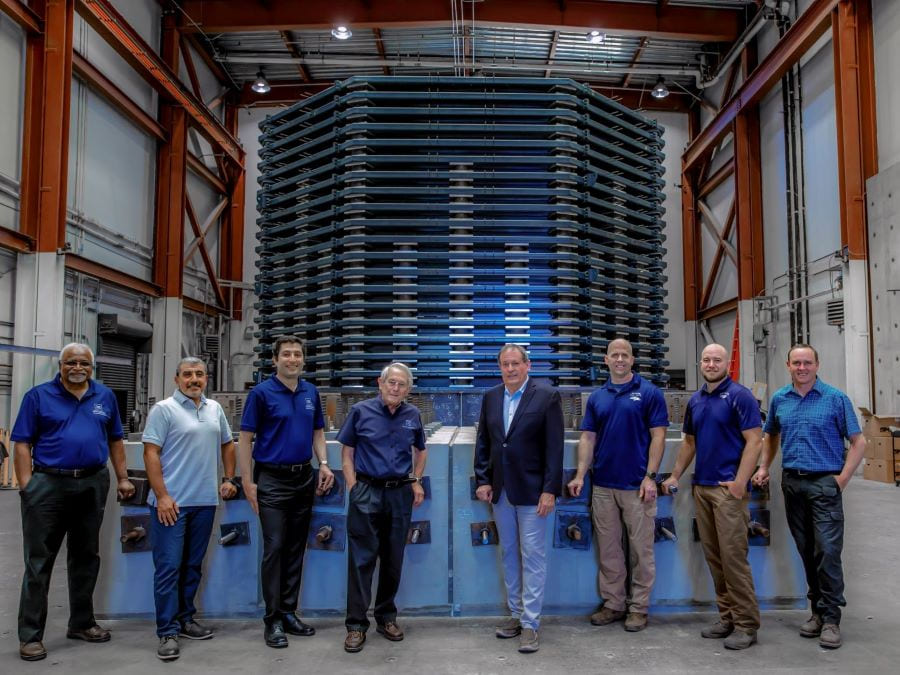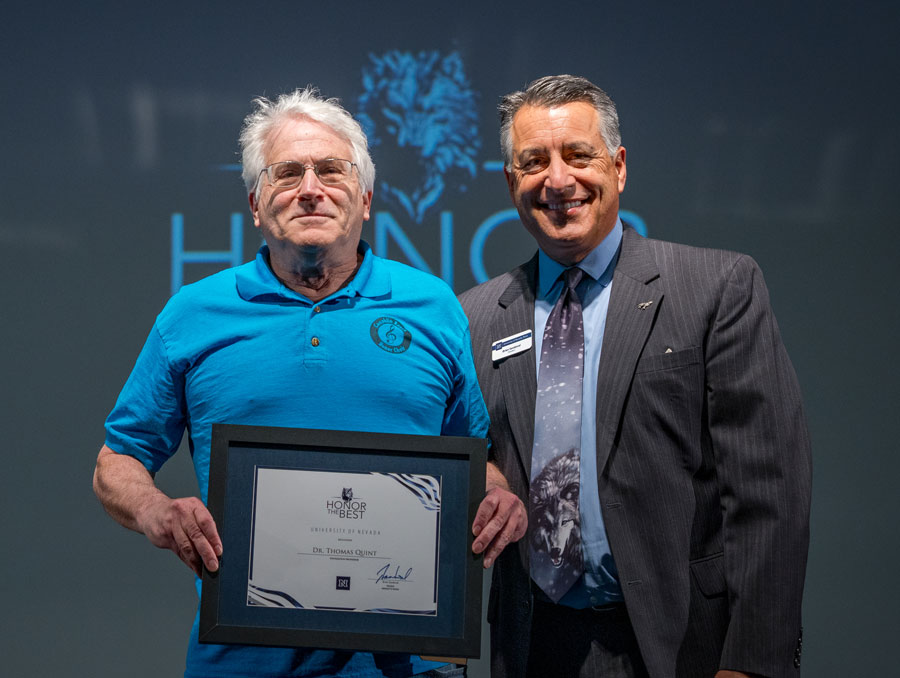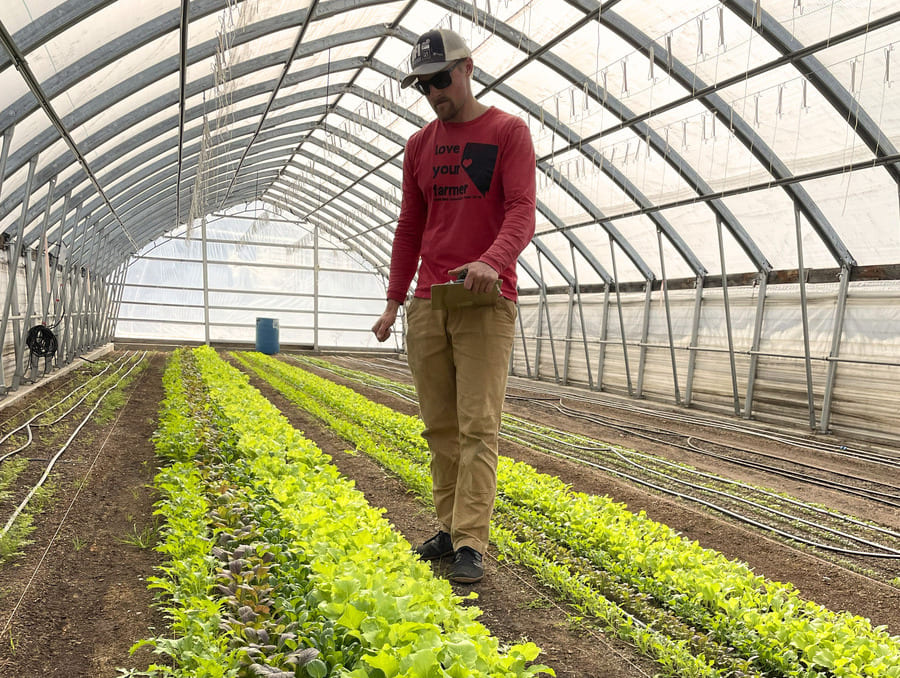The new Large-Scale Laminar Soil Box System is the latest addition to the University of Nevada, Reno’s world-renowned earthquake engineering complex. It is the largest such facility in the U.S. and comparable in size to the largest in the world. Factor in its unprecedented level of flexibility, and the Soil Box System is truly a one-of-a-kind experimental facility and a model of engineering innovation.
When it came to designing and constructing this massive and versatile facility, it wasn’t necessary to look far for the engineering know-how and experience. Foundation Professor Ian Buckle, of the University’s Center for Civil Engineering Earthquake Research (CCEER) and principal investigator for the soil box project, joined with Patrick Laplace and Sherif Elfass, research associate professors and design leads on the project. After all, Laplace had designed the University’s triaxial shake table, also called the 6-Degree-of-Freedom table, and Elfass had designed two other soil boxes for shake-table testing.
“This team has remarkable depth of experience and knowledge when it comes to designing and fabricating a one-of-a-kind experimental facility."
“This team has remarkable depth of experience and knowledge when it comes to designing and fabricating a one-of-a-kind experimental facility. Their track record for successful completion of unique experimental systems was key to looking to UNR for the system design,” said David McCallen, project leader for the sponsor and CCEER director.
The Soil Box System will provide important data for advancing the simulation of earthquakes and allow evaluation of the complex manner in which structural systems like buildings and bridges interact with the surrounding soil during the event. Its design and construction were supported by the U.S. Department of Energy (DOE). The project was launched in 2015 out of a need to safeguard DOE buildings that hold sensitive scientific instruments against potential earthquake scenarios.
James McConnell, associate principal deputy administrator for DOE’s National Nuclear Security Administration, said, “It’s important for DOE and NNSA to invest in this work to ensure that the large, complicated, one-of-a-kind facilities we build are designed to protect the country’s research, defense, and energy-generation needs, but the findings have an added benefit of helping engineers and architects in industry and the private sector build a wide range of earthquake-resilient structures.”
The 15-foot-high and 21.5-foot-wide soil box sits on a 24-foot square platen or platform that can be shaken by sixteen hydraulic actuators used to generate horizontal motions as if in an earthquake. The soil box has 19 layers, called laminates, that are each supported on bespoke elastomeric (rubber) bearings so that the soil layers can move relative to each other like they do in actual earthquakes. To create earthquake motions in the laboratory, the system can displace and accelerate up to 350 tons of soil in two horizontal directions simultaneously with the same force as a strong earthquake, and is so powerful that the designers had to build-in safeguard controls to ensure the system could not damage itself during experiments. The system’s hydraulics are controlled by custom software and the box is equipped with a suite of sensors to allow detailed datasets to be gathered under carefully controlled prescribed earthquake motions.
“There are very few organizations or companies with the knowledge and expertise to do this, so we decided to do it ourselves with our own expertise and resources,” said Buckle. “This design not only allows us to work with large-scale structural models that can be embedded in soil, but also the size of the box allows more realistic soil properties to be modeled.”
Laplace, who designed much of the shake table system, including the platen, hydraulics, actuators, reaction buttreses, and electrical and supporting control systems, said, “It’s complicated and big – a giant system.”
The system is designed to simulate different types of seismic activity, and it can be reconfigured to accommodate and represent different types of soils. This versatility, said Laplace, will allow it to support a wide variety of research opportunities.
“Soil needs to be representative of a particular site, but is difficult to prepare at the right consistency,” he said. “This is where research comes in. As we achieve levels of experimental certainty, our tests will contribute to improved design, construction effectiveness and reduced construction time. This is a new area of construction and engineering.”
Looking back on the project – from concept to the completion of successful demonstrations in late summer 2022 – Elfass describes a process that involved considerable testing, risk mitigation, “artistic effort” and persistence. When faced with a challenge, Elfass said, “We pushed things forward.”
“We say ‘yes.’ Then we look for ways to do it,” Elfass added.
Other team members on this challenging project were technicians Chad Lyttle and Todd Lyttle who excuted the complex construction. College of Engineering Professor Raj Siddharthan and Associate Professor Ramin Motamed provided valuable advice to the project.
Several local companies provided essential components to the project including Dynamic Isolation Systems, Motion and Flow Control Products, Precision Metals, Remarc Manufacturing, Reno Iron Works and Western Nevada Supply.
Experiments conducted with the Soil Box System will provide data for another national effort, EQSIM: an ongoing collaboration between scientists at the Lawrence Berkeley National Lab, Lawrence Livermore National Laboratory and the University of Nevada, Reno to develop realistic, highly detailed earthquake simulations using DOE’s cutting-edge supercomputers.
Using these exceptionally fast machines, the longstanding goal of computational modeling of a full regional-scale, rupture-to-structure sequence is becoming a reality. Their ground motion simulations will then be made available to the public through the Pacific Earthquake Engineering Research Center’s open-access database of earthquake ground motions. PEER is a multi-institution research center focused on performance-based earthquake engineering, led by UC Berkeley and of which the University of Nevada, Reno is a member.
“Together, our work will inform the DOE’s interests in facility safety, but the Laminar Soil Box also will be available to a broad spectrum of earthquake safety stakeholders,” College of Engineering Dean Erick Jones said. “This corresponds to the College’s commitment to equitable community infrastructure to mitigate cascading local, regional and global hazards.”
Visit the University’s Center for Civil Engineering Earthquake Research website for more information.
Photo caption: The design and construction team (l-r): Professor Raj Siddharthan, Research Associate Professor Sherif Elfass, Associate Professor Ramin Motamed, Foundation Professor Ian Buckle, project lead and Director of the University’s Center for Civil Earthquake Engineering Research David McCallen, Research Associate Professor Patrick Laplace, Technician Todd Lyttle and Technician Chad Lyttle.
Note: Aliyah Kovner, science writer & podcast producer, Lawrence Berkeley National Laboratory, and Mike Wolterbeek, communications officer, University of Nevada, Reno, contributed to this story.
















